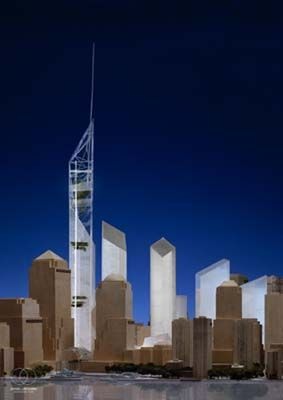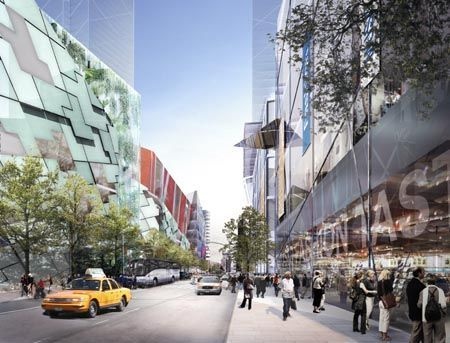World Trade Center
Daniel Libeskind
Memory Foundations
I arrived by ship to New York as a teenager, an immigrant, and like millions of others before me, my first sight was the Statue of Liberty and the amazing skyline of Manhattan. I have never forgotten that sight or what it stands for. This is what this project is all about.
When I first began this project, New Yorkers were divided as to whether to keep the site of the World Trade Center empty or to fill the site completely and build upon it. I meditated many days on this seemingly impossible dichotomy. To acknowledge the terrible deaths which occurred on this site, while looking to the future with hope, seemed like two moments which could not be joined. I sought to find a solution which would bring these seemingly contradictory viewpoints into an unexpected unity. So, I went to look at the site, to stand within it, to see people walking around it, to feel its power and to listen to its voices. And this is what I heard, felt and saw.
The great slurry wall is the most dramatic element which survived the attack, an engineering wonder constructed on bedrock foundations and designed to hold back the Hudson River. The foundations withstood the unimaginable trauma of the destruction and stand as eloquent as the Constitution itself asserting the durability of Democracy and the value of individual life.
We have to be able to enter this ground while creating a quiet, meditative and spiritual space. We need to journey down, some 30 feet into the Ground Zero Memorial site, past the slurry wall, a procession with deliberation.
The foundation, however, is not only the story of tragedy but also reveals the dimensions of life. The Path trains continue to traverse this ground now, as before, linking the past to the future. Of course, we need a Museum at the epicenter of Ground Zero, a museum of the event, of memory and hope. The Museum becomes the entrance into Ground Zero, always accessible, leading us down into a space of reflection, of meditation, a space for the Memorial itself. This Memorial will be the result of an international competition.
Those who were lost have become heroes. To commemorate those lost lives, I created two large public places, the Park of Heroes and the Wedge of Light. Each year on September 11th between the hours of 8:46 a.m., when the first airplane hit and 10:28 a.m., when the second tower collapsed, the sun will shine without shadow, in perpetual tribute to altruism and courage.
We all came to see the site, more than 4 million of us, walking around it, peering through the construction wall, trying to understand that tragic vastness. So I designed two ramps, one from Liberty Street running along the great slurry wall and one from Greenwich, behind the waterfall to the southern edge of the site. Now everyone can see not only Ground Zero Memorial site but the resurgence of life.
The exciting architecture of the new Lower Manhattan Rail station with a concourse linking the Path trains, the subways connected, hotels, a performing arts center, office towers, underground malls, street level shops, restaurants, cafes; create a dense and exhilarating affirmation of New York.
The sky will be home again to a towering spire of 1776 feet high, the Antenna Tower with gardens. Why gardens? Because gardens are a constant affirmation of life. A skyscraper rises above its predecessors, reasserting the pre-eminence of freedom and beauty, restoring the spiritual peak to the city, creating an icon that speaks of our vitality in the face of danger and our optimism in the aftermath of tragedy. Life victorious.
Daniel Libeskind
New York
Febuary, 2003

























